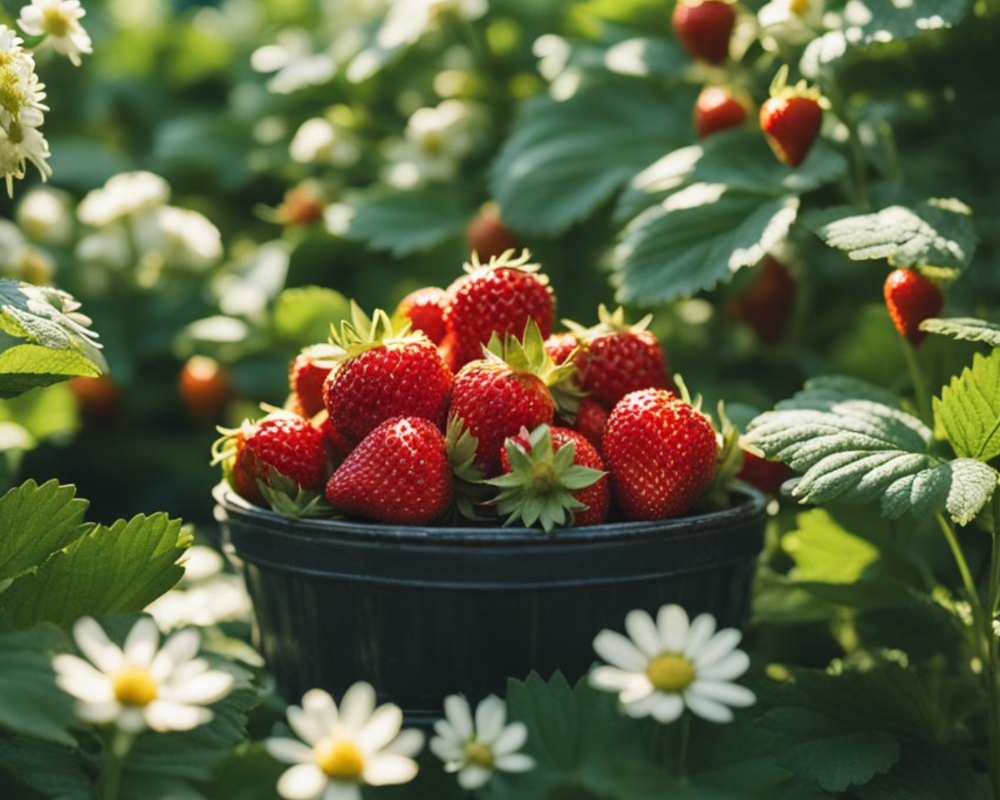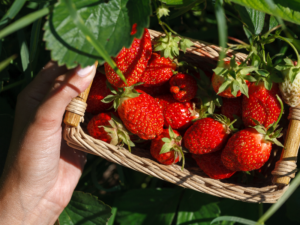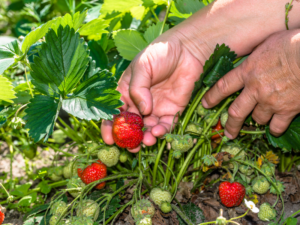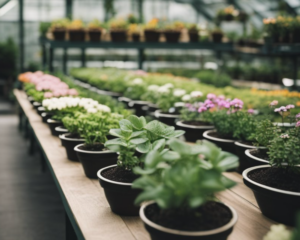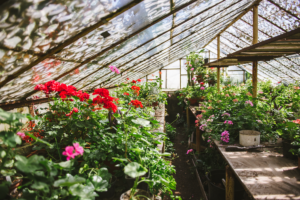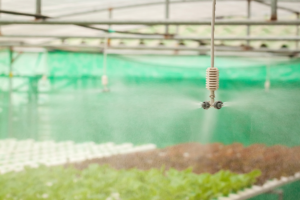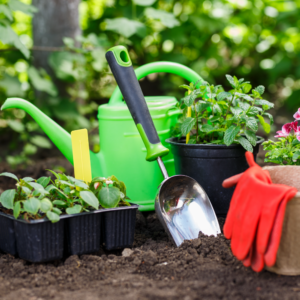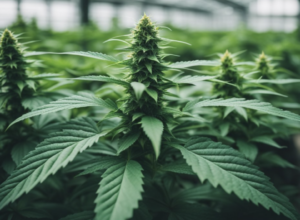Growing strawberries in a greenhouse is kind of like giving these sweet, red berries a VIP pass to the good life. By growing them under the protective cover of a greenhouse, I’m able to dodge a lot of the issues outdoor berries face. Think about it: no unexpected frosts nipping at their blossoms, fewer insects treating them like a buffet, and I can control the climate to be just right. That means I can enjoy strawberries earlier in the season, and if I play my cards right, I might just keep them coming until the frost hits again.
Handling greenhouse strawberries isn’t all sunshine and daisies though. It takes a good bit of effort to maintain the perfect growing environment. I’ve got to keep an eye on the temperature and humidity levels, making sure they’re always in the sweet spot—not too hot, not too cold, and just the right amount of moisture in the air. Then there’s the soil; it’s got to be rich and well-drained because no one likes waterlogged roots, especially not strawberry plants.
By tweaking the conditions to mimic Mother Nature at her best, I can grow some seriously plump and juicy strawberries. They’re the kind that burst with flavor the second you pop them in your mouth. Sure, it’s a bit more work than planting them outside and hoping for the best, but the payoff? Well, it’s absolutely worth it when I can wander into my greenhouse and pick a handful of ripe, delicious berries any time I want.
Benefits of Greenhouse Strawberry Cultivation
Growing strawberries in a greenhouse has transformed my farming game. I’ve switched to greenhouse production for these red gems, and it’s brought in a handful of solid advantages. Here’s the scoop on why greenhouse strawberries are my go-to:
- Extended Growing Season: In my greenhouse, strawberries aren’t limited to traditional growing seasons. I can produce these berries year-round, dodging the constraints of external weather conditions. It’s like summer every day in there!
- Quality Control: With a controlled environment, I’m the boss of temperature, humidity, and watering schedule. This level of control reduces the risk of pests and diseases, which means I get to harvest top-notch strawberries consistently.
- Efficient Use of Space: I’ve noticed that greenhouse strawberry cultivation maximizes space usage. I can set up multi-level growing systems that boost my yield per square foot as compared to field cultivation.
- Eco-Friendly: I strive to do my bit for the environment, and growing strawberries in a greenhouse allows for efficient water use and less pesticide application. My ecological footprint is smaller since the controlled conditions require fewer chemicals.
In my experience, these strawberries are sweeter, and I don’t have to play the waiting game with Mother Nature. Plus, my neighbors love getting juicy strawberries even when it’s snowing outside!
Varieties of Strawberries
When I’m looking at various strawberries to grow in my greenhouse, I consider their harvest times and flavor profiles. Let’s check out three main types of strawberries I focus on: June-bearing, everbearing, and day-neutral.
June-Bearing Strawberries
These types are my go-to for a large, concentrated harvest in late spring to early summer. ‘San Andreas’ is a standout cultivar with its high yield and disease resistance. They’re perfect if you, like me, want to enjoy or preserve plenty of strawberries at once.
Cultivars to consider:
- ‘San Andreas’: Bold flavor, large fruit, disease-resistant
- ‘Chandler’: Sweet, large berries, good for fresh consumption
Everbearing Strawberries
I find everbearing strawberries a bit misnamed, as they don’t actually bear fruit continuously. Instead, they give me two to three harvests: one in early summer, one in late summer, and sometimes a light picking in early fall. ‘Albion’ is a popular choice for its sweet flavor and consistent berry size throughout the season.
Cultivars to consider:
- ‘Albion’: Sweet, firm berries, heat-tolerant
- ‘Seascape’: Robust flavor, performs well in different soils
Day-Neutral Strawberries
Day-neutral strawberries are my favorite for steady production. Regardless of daylight hours, these cultivars produce fruit throughout the growing season. They are less sensitive to the change in seasons, making them ideal for my greenhouse.
Cultivars to consider:
- ‘Tristar’: Sweet, smaller berries, performs well in heat
- ‘Albion’: (also fits day-neutral) Consistent yield, excellent flavor
By understanding these types, I can plan my greenhouse for continuous harvest or a bumper crop, depending on my needs and preferences.
Setting Up the Greenhouse
Before I dive into the details, I want to point out that choosing a spot with ample sunlight, ensuring proper airflow, and meeting the light needs of strawberries are essential for a thriving greenhouse.
Choosing the Right Location
When I’m hunting for the perfect spot to place my greenhouse, I make sure it gets maximum sunlight, especially during the winter. Orientation is crucial; an east-west orientation ensures that my strawberries get consistent light throughout the day.
- Direction: East-West orientation for uniform light distribution
- Considerations:
- Avoid shaded areas from trees or buildings
- Proximity to water source and power supply
Ensuring Optimal Ventilation and Humidity
I can’t stress enough how important ventilation is. It keeps the air moving and prevents mold and pests, which strawberries dislike. Here’s how I keep the balance:
- Ventilation: Use manual or automatic vents, considering roof and side vents for cross-ventilation
- Humidity Control:
- Aim for 50-70% relative humidity in the greenhouse
- Use a hygrometer to monitor humidity levels consistently
Lighting Requirements and DLI
Strawberries crave light, and I make sure they have enough to grow sweet and plump. The Daily Light Integral (DLI) is key to understanding how much light my plants get over a period of time.
- Sunlight: 6-8 hours of direct sunlight per day
- DLI: Target a DLI of 12-14 moles per day for healthy growth
- Supplemental Lighting: If needed, add LED or HID lights to hit the DLI target
- Lighting Schedule: Adjust based on the season and natural light availability
Soil and Growing Mediums
When I’m setting up for greenhouse strawberries, I pay special attention to the soil and growing mediums since they’re crucial for healthy plant development.
Importance of Drainage
I can’t stress enough how vital proper drainage is for strawberries. They hate sitting in waterlogged soil—it spells disaster, causing root rot and all sorts of trouble. I always make sure to use a well-draining mix. If I’m using pots, I check that they have enough holes at the bottom. When it comes to raised beds, I increase drainage by elevating the soil level and adding coarse materials like gravel or perlite.
Organic Matter and Compost
Strawberries thrive with a boost of organic matter. It’s like a treasure trove of nutrients. I add compost to the soil—it’s like giving strawberries a multi-vitamin. Here’s how I ensure a rich mix:
- Start with a base of high-quality garden soil.
- Fold in generous amounts of compost—it’s like gold for strawberry roots.
- I sometimes add a bit of fertilized mix if the compost isn’t rich enough.
- I ensure consistent nutrient content throughout the beds or pots.
Adding organic matter not only feeds my strawberries but also keeps the soil structure in prime condition for the plants’ growth cycles. It retains moisture just right and lets the roots breathe.
Planting Strategies
When I plant strawberries in a greenhouse, I focus on three main strategies: seedlings and their spacing, using containers and hanging baskets, and hydroponic systems. These methods have proved effective in maximizing my space and yield.
Seedlings and Plant Spacing
I start with healthy seedlings, as they’re essential for a robust strawberry crop. My go-to spacing is about 18 inches apart in rows that are 30 inches apart. This allows for optimal air circulation and sunlight exposure, which is critical for growth.
- Seedlings: Purchase from reputable suppliers.
- Spacing: 18″ between plants, 30″ between rows.
Using Containers and Hanging Baskets
Containers and hanging baskets are fantastic for saving space and adding versatility. I use containers at least 8 inches deep and pots around 12 to 15 inches in diameter for best results. Hanging baskets bring a vertical element to my greenhouse.
- Containers: At least 8″ deep, with ample drainage holes.
- Hanging Baskets: Sufficiently sturdy to support the weight of the soil and plants.
Hydroponic Systems
Hydroponic systems are a game-changer for me. They allow for planting strawberries without soil, using a solution rich in nutrients instead. This method can increase turnover and is particularly great when space is limited.
- System: Choose one that fits your greenhouse size.
- Nutrients: Use a balanced mix for leaf and fruit production.
Nutrients and Fertilization
When I grow strawberries in a greenhouse, I pay close attention to their diet. The right mix of nutrients and on-point fertilization are crucial.
Balanced Fertilizer Use
For my strawberries, I aim for a balanced fertilizer that promotes healthy growth without overdoing any single element. Balanced fertilizers contain equal or appropriate ratios of the major nutrients: nitrogen (N), phosphorus (P), and potassium (K). I follow the recommended N-P-K ratios for strawberry plants, often something like 10-10-10 or 12-12-12, reading the instructions to match my plants’ growth stage. I also ensure there’s adequate organic matter by adding compost, which provides a slow-release of nutrients and improves the soil structure.
- Nitrogen: Helps with leaf growth.
- Phosphorus: Vital for root development and fruit quality.
- Potassium: Crucial for overall plant health and disease resistance.
I apply this balanced fertilizer throughout the growing season, following the instructions closely to avoid nutrient burn, which can occur from over-fertilization.
Potassium and Micronutrient Requirements
Potassium stands out in importance for strawberries in my greenhouse. It’s key for their growth, photosynthesis, and fruit quality. I always make sure they get enough of it, particularly during the fruiting stages. Besides potassium, strawberries need micronutrients like magnesium (Mg), calcium (Ca), and sulfur (S) in smaller quantities.
Here’s a mini-table I put together that lists some of the micronutrients and their primary benefits for my strawberry plants:
I keep an eye on the color and health of the leaves and fruit, which can indicate if there’s a deficiency. When needed, I’ll apply a separate micronutrient fertilizer to balance the requirements. Regular soil testing helps me stay on top of their nutritional needs and adjust my fertilization approach accordingly.
Watering and Irrigation
In my experience, the success of growing greenhouse strawberries heavily relies on efficient watering and irrigation methods. I find that keeping roots consistently moist without overwatering is key.
Drip Irrigation Systems
I’ve observed that drip irrigation stands as one of the most effective systems for greenhouse strawberries. With this system, water is delivered directly to the base of the plant, which not only ensures that each plant gets the attention it requires but also significantly reduces water waste.
- Advantages:
- Saves Water: I’ve noted that drip systems can save up to 60% more water than traditional sprinklers because of targeted delivery.
- Weed Reduction: Since water goes right to the plant, surrounding areas stay dry, discouraging weed growth.
- Setup:
- Emitter: I install emitters about 18 inches apart, ensuring an even distribution.
- Pressure Regulator: A vital piece of equipment to maintain consistent water pressure.
- Maintenance:
- Flushing: Regular flushing of the system helps prevent clogging.
- Inspection: I vigilantly check for leaks and damages that can disrupt water flow.
By implementing a drip irrigation system, I maintain a balance between too much and too little water, tackling one of the most common challenges in growing strawberries in a greenhouse setting.
Pollination in the Greenhouse
When I’m growing strawberries in my greenhouse, I focus on ensuring effective pollination, which is crucial for fruit set.
Role of Bees
In my greenhouse, bees are the workhorses of pollination. I introduce bumblebees because they’re efficient and can work in confined spaces. They have this unique method called buzz pollination, where they grab onto the flower and vibrate rapidly to release pollen. This enhances the pollination process and leads to better fruit development.
Manual Pollination Methods
Sometimes, though, I can’t rely on bees alone, especially if bee activity is low or I’m managing a small-scale setup. That’s when I turn to manual pollination. I use a small paintbrush or an electric toothbrush to mimic the action of bees. Gently touching the paintbrush to the inside of a flower transfers the pollen to the stigma. This method is meticulous and time-consuming, but it’s effective when I’m aiming for precision in pollination.
- Manual Tools:
- Paintbrush
- Electric toothbrush
- Steps:
- Gently swirl the brush inside the flower.
- Move from flower to flower to spread the pollen.
By combining these methods, I ensure that my greenhouse strawberries have the best chance to develop into those juicy, red fruits we all love.
Pest and Disease Management
In my experience with greenhouse strawberries, keeping pests at bay and managing diseases is crucial for healthy crops. It’s about knowing what to look for and taking the right steps to prevent issues before they start.
Common Strawberry Pests
Aphids and spider mites are my regular unwelcome guests. I keep a close eye for their presence, as they can quickly weaken plants by feeding on their sap. My pest control strategy includes:
- Monitoring: Regular checks of the underside of leaves.
- Natural predators: Releasing beneficial insects like ladybugs.
- Control measures: Applying neem oil or insecticidal soap primarily when infestations are spotted.
For instance, if I spot a few aphids, I might introduce ladybugs into the ecosystem, which are natural predators of these pests.
Dealing with Diseases and Rot
Grey mould (Botrytis cinerea) and powdery mildew are the usual disease culprits. As for rot, keeping an eye out for any soft, brown areas on the fruit is key; that’s a sign of trouble. My approach involves:
- Air circulation: Ensuring good ventilation to discourage mould growth.
- Sanitation: Removing and discarding infected plant material promptly.
- Fungicides: Applying as necessary, following label directions strictly.
If I spot signs of powdery mildew, a common disease, I make sure to increase air flow around my plants to reduce moisture.
Importance of Disease-Free Seedlings
Starting with disease-free seedlings is my first line of defense against pathogens like verticillium wilt. It’s all about:
- Sourcing: Buying from reputable suppliers who test for diseases.
- Inspection: Personally examining new plants for signs of infection.
By starting with clean plants, I significantly reduce the risk of introducing diseases to my greenhouse.
Growing Season and Harvest
I’m about to walk you through the ins and outs of the growing season for strawberries and the best practices to harvest these sweet, ruby-red berries. Expect to learn when they’re ripe for the picking and how to do it right.
Understanding the Strawberry Growing Season
In my experience, strawberries typically thrive during the cooler times of spring and fall. It’s crucial to know that they don’t tolerate frost, so I make sure to time the planting after the last frost of spring. As for regions with milder climates, I’ve found that strawberries can be grown all year round.
Planting Dates:
- Spring crop: After last expected frost
- Fall crop: Late summer or early fall
Strawberry Growth Timeline:
- Day 0-30: Plant development, establish runners
- Day 30-60: Flowering starts, prepare for pollination
- Day 60-90: Berries develop, monitor for ripe color
Optimal Harvesting Practices
When my strawberries start showing a full red color and the scent is irresistible, that’s my cue for harvest. I pick them carefully each morning when they are cool and the sugars are settled. It’s crucial to harvest them every two to three days, as this is when ripe berries will be ready.
Harvesting Checklist:
- Color Check: 100% red surface
- Scent Test: Sweet, strong aroma
- Gentleness: Lightly twist berries off the stem
- Storage: Use shallow containers to avoid bruising
By following these steps, I make sure I get the best out of my strawberry plants and enjoy a bountiful harvest.
Challenges and Solutions
In my experience growing strawberries in a greenhouse, I face a couple of recurring issues, but I’ve found ways to manage them effectively.
Temperature and Humidity Regulation
Challenges: Keeping the delicate balance of temperature and humidity just right is crucial for my strawberries. They hate it too hot or too cold, and excess moisture welcomes diseases like powdery mildew.
Solutions:
- Ventilation: I use automatic vent openers that kick in when it gets too warm.
- Heating: On chilly nights, a thermostatically controlled heater keeps the cold at bay.
- Humidistat: To control humidity, a humidistat connected to a dehumidifier works wonders.
Results: Over time, I’ve dialed in the sweet spot: 70-85°F for day, 60-65°F at night, with humidity around 80%.
Greenhouse Space Management
Challenges: Space in a greenhouse can get tight, and strawberries don’t like being overcrowded. Plus, juggling space for walking and maintenance is a bit like playing Tetris.
Solutions:
- Vertical Farming: I’ve set up tiered shelving units, which lets me grow upwards.
- Container Sizes: I opt for containers that are big enough for the plants but small enough to maximize space.
- Pathways: I always ensure there’s just enough room for me to navigate for tending and harvesting.
Outcomes: This approach helps me squeeze out every inch of my greenhouse without stressing out my strawberry plants.
Year-Round Production
Growing strawberries in a greenhouse has revolutionized my ability to produce these sweet berries all year long. Whether it’s winter’s chill or the summer heat, the controlled environment of a greenhouse ensures that I don’t have to stop at traditional growing seasons.
Off-Season Growing
I’ve found that the off-season is no longer an obstacle. By managing temperatures and providing the right care, I can harvest strawberries even when it’s freezing outside. Here’s a quick look at the essentials:
- Temperature Control: Maintaining a steady temperature between 65°F to 75°F.
- Humidity Management: Keeping humidity levels at approximately 80%.
Using Supplemental Lighting
To mimic the long days of summer during shorter winter days, I rely on supplemental lighting. Here’s how I configure my lighting setup:
- Light Type: LEDs or high-pressure sodium (HPS) lights that emit full-spectrum light.
- Duration: A minimum of 8 to 10 hours of light per day, depending on the growth stage of my strawberries.
Advanced Techniques
When I talk about raising the bar for my strawberries in the greenhouse, advanced techniques are my go-to methods. They involve careful runner management, hydroponic systems, and precise climate control, each becoming a game-changer in their own right.
Pruning and Training Runners
My experience tells me that strawberry runners need to be pruned and trained properly for optimal growth. I make sure to selectively keep a couple of the most vigorous runners from each plant and snip the rest. This focuses the plant’s energy on fruit production rather than spreading out. I train the remaining runners to grow in the direction I want by gently placing them onto the soil and sometimes using small weights to keep them in place. This careful management ensures I get a good number of daughter plants to expand my strawberry empire!
Adopting Hydroponics for Strawberries
Here’s the lowdown on hydroponics: it’s a soil-less wonder for my strawberries. I use a hydroponic system which involves a nutrient-rich water solution for the plants’ roots directly. It’s a clean and efficient way to grow, and I can tell it’s more space-saving too. Check out the basic setup I’ve tried:
- Reservoir: Holds the nutrient solution.
- Substrate: I prefer rockwool or coconut coir.
- Pump: To circulate the solution.
- Timer: For regulating the feeding cycles.
My plants grow faster and are less subject to diseases, which makes it a win-win in my book.
Greenhouse Tuning for Climate Control
Getting the climate just right in my greenhouse, also known to some as a tunnel greenhouse, involves a few steps:
- Monitoring: I keep tabs on temperature and humidity levels.
- Heating and Cooling: Depending on the outdoor weather, I might crank up a heater or use shade cloths and ventilation.
- Dehumidifiers: To ward off excess moisture that can lead to mold.
By automating most of these features, I maintain the perfect climate, and my strawberries absolutely thrive.
Enjoying the Fruits
Strawberry season is always a delight. Those sweet, ripe berries hit the taste buds just right, and their quality is undeniable, especially when they’re grown in local greenhouses.
Strawberry Recipes and Uses
I’ve found that strawberries fresh from the greenhouse are perfect for a variety of dishes. Here’s a quick table of my go-to recipes:
When these berries are local and just picked, the taste is phenomenal, and I get the best results in my recipes. To me, there’s something special about knowing these strawberries didn’t travel far to reach my kitchen.
For that top-notch berry quality, I always look for plump, bright red strawberries with a vibrant green cap. I make sure they’re ripe but firm to the touch—those are the best for both eating fresh and culinary creations.
Frequently Asked Questions
I’ve curated answers to some of the most common inquiries about cultivating strawberries in a greenhouse. These specifics should guide and assist in understanding the aspects of year-round strawberry growth.
How can you grow strawberries in a greenhouse during winter?
In winter, I maintain a stable temperature in my greenhouse, ideally around 65-75°F (18-24°C) during the day and not below 55°F (13°C) at night. I make sure my plants get sufficient light, either naturally or through supplemental grow lights, and keep the humidity levels in check to mimic the spring environment strawberries crave.
What’s the difference between greenhouse-grown strawberries and organic ones?
Greenhouse-grown strawberries are cultivated in a controlled environment which could include conventional or organic methods. On the other hand, organic strawberries, whether grown in a greenhouse or open field, adhere to organic farming standards avoiding synthetic pesticides and fertilizers.
What are some effective designs for a strawberry greenhouse?
I’ve found A-frame and gothic arch designs effective for strawberry greenhouses. Both allow for ample light and have adequate ventilation which is key for strawberry plants. I always make sure the interior layout optimizes space with vertical farming or stacked pots.
Is year-round strawberry cultivation possible in a greenhouse environment?
Yes, it’s possible. I ensure the greenhouse has proper heating, cooling, and supplemental lighting systems. This way, the strawberry plants get their required climate conditions and photoperiod throughout the year.
How do you manage pollination for strawberries in a greenhouse?
To manage pollination, I introduce bumblebees which are great pollinators for strawberries. Alternatively, I sometimes use a handheld pollinator or gently shake the flowering plants to distribute pollen if introducing insects isn’t feasible.
What’s the best way to grow strawberries in pots within a greenhouse?
I opt for pots with good drainage and use a high-quality potting mix. I place the pots where they can get ample light and keep the soil consistently moist but not waterlogged. Regular feeding with a balanced fertilizer helps the strawberry plants thrive.

